Abstract
Lipid compositions of 40 patient isolates of Mycobacterium tuberculosis derived from Madras, Burma, Rangoon, and East Africa were studied, and two major populations of tubercle bacilli were distinguished. Nearly all of the strains previously designated as attenuated for the guinea pig (D. A. Mitchison) are characterized by a specific phenolic phthiocerol diester which is identified with the aglycone moieties of mycosides A and B (and probably G). This lipid (AI) was not seen in any of the more virulent strains. Thus, presence of AI may be taken as definitive for attenuation (P ≪ 0.001). Phthiocerol dimycoserosate (DIM), a companion substance, is ubiquitous for the series of 40 strains. However, a dramatic attenuation found in a DIM-less H37Rv mutant may support a role for this substance in the virulent state. Since mycosides A, G, and B seem to be restricted to certain chromogenic and bovine species, respectively, we speculate that lysogenization or transduction of fully virulent M. tuberculosis may have provided the genetic determinants for attenuation and AI synthesis, and thus led to the two classes of tubercle bacilli.
Full text
PDF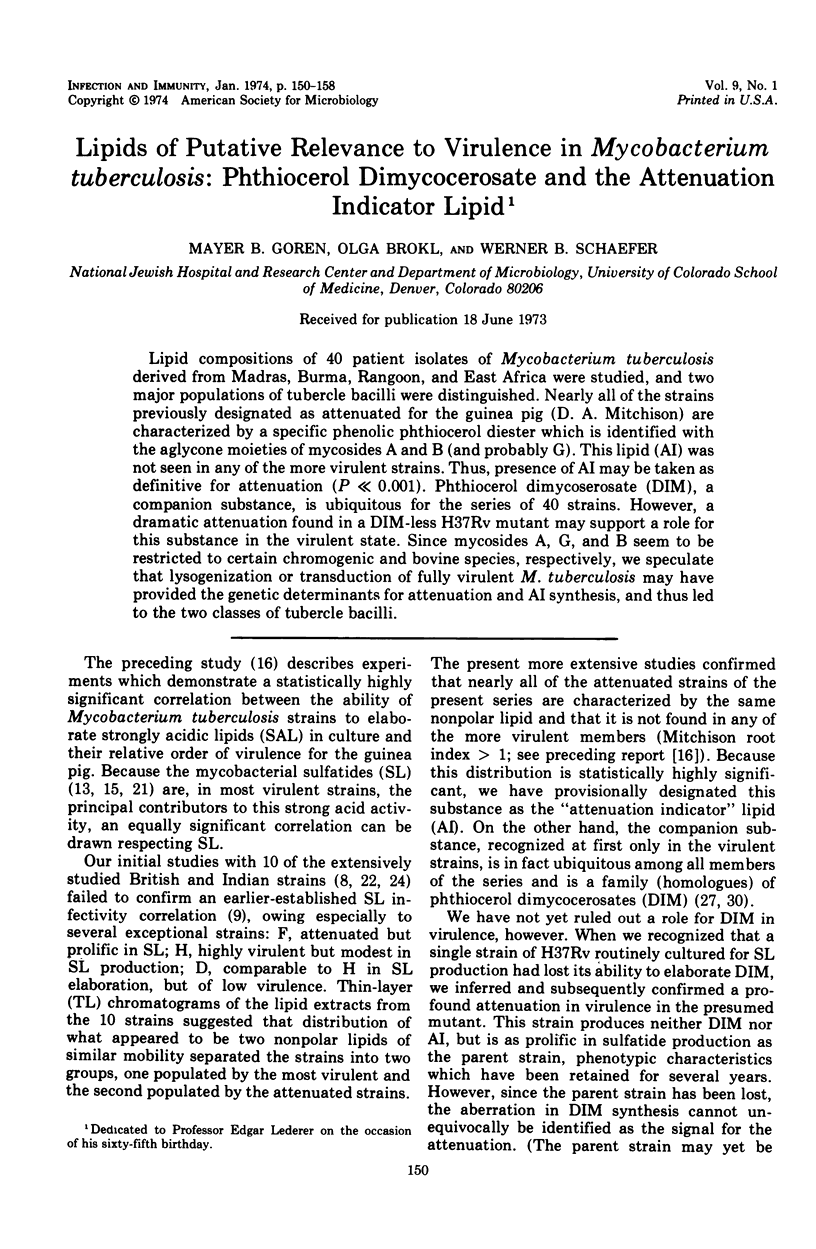

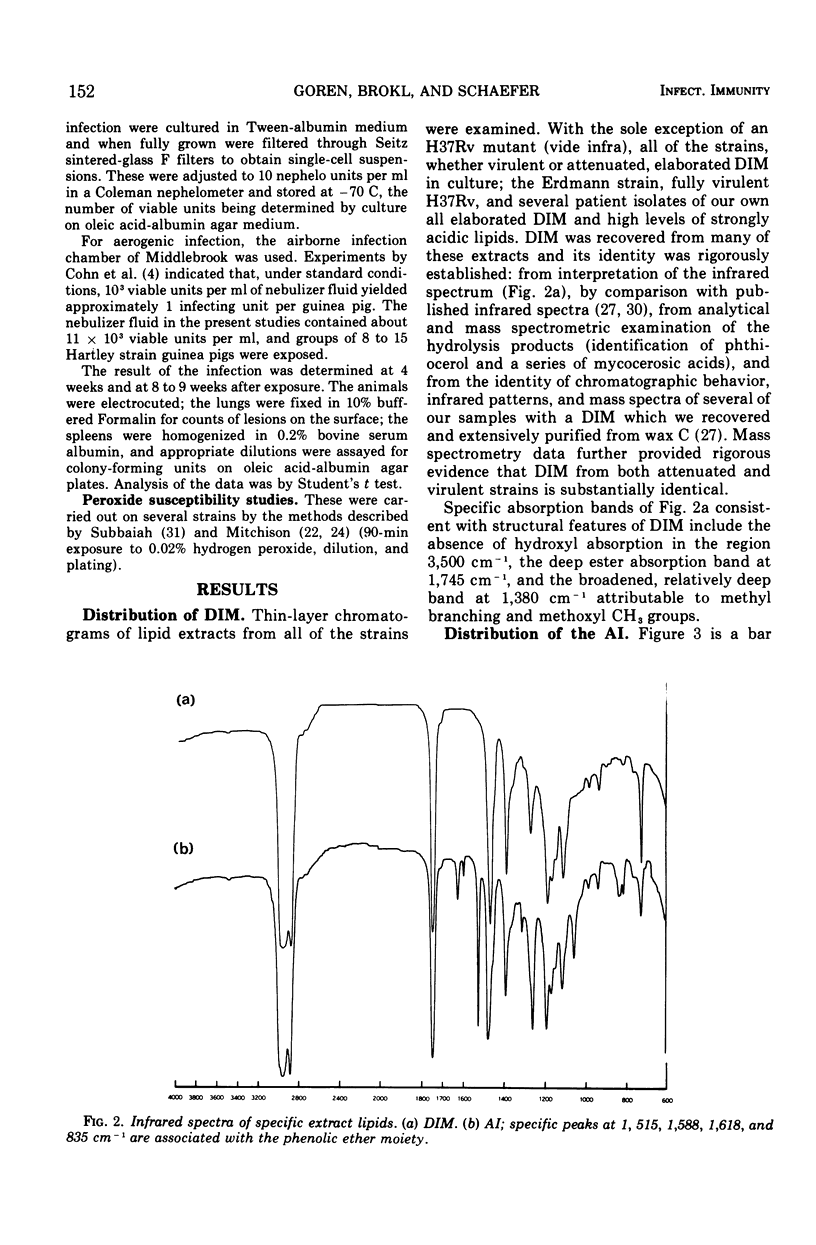
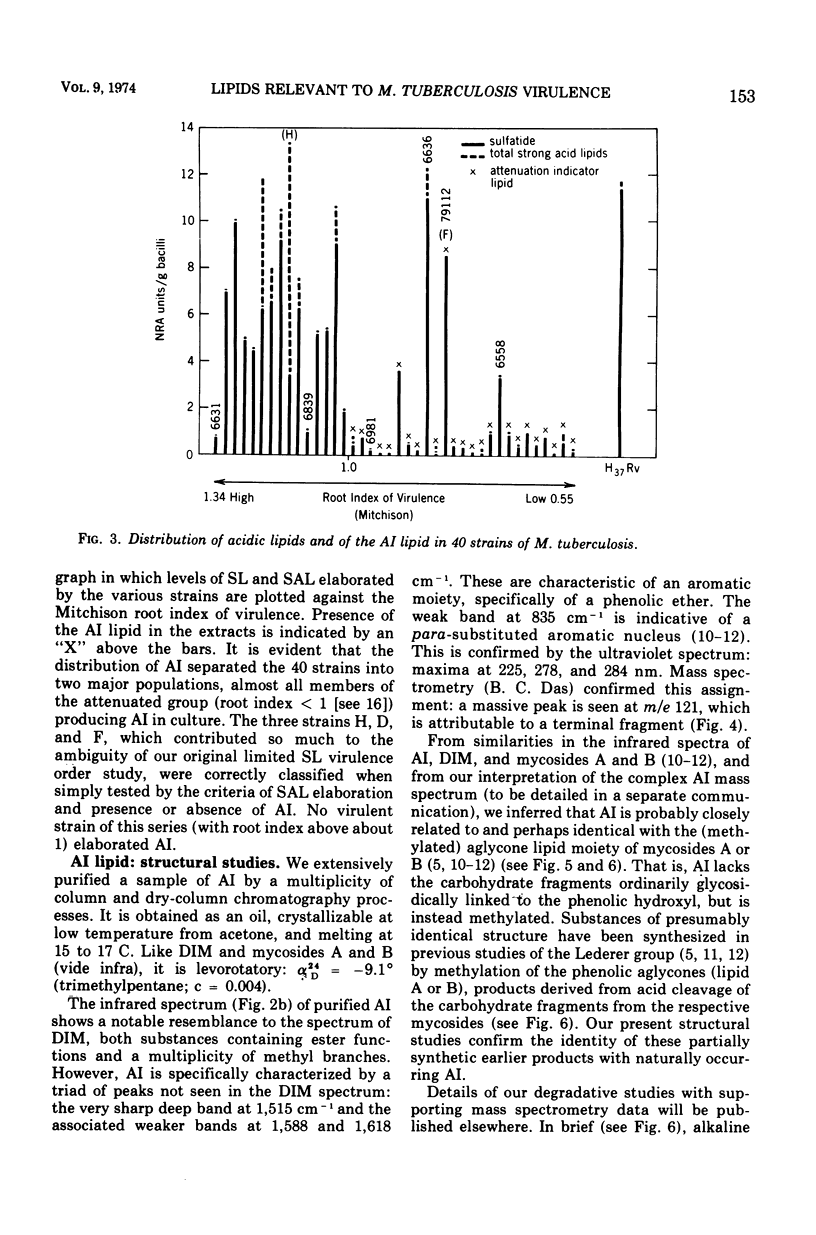



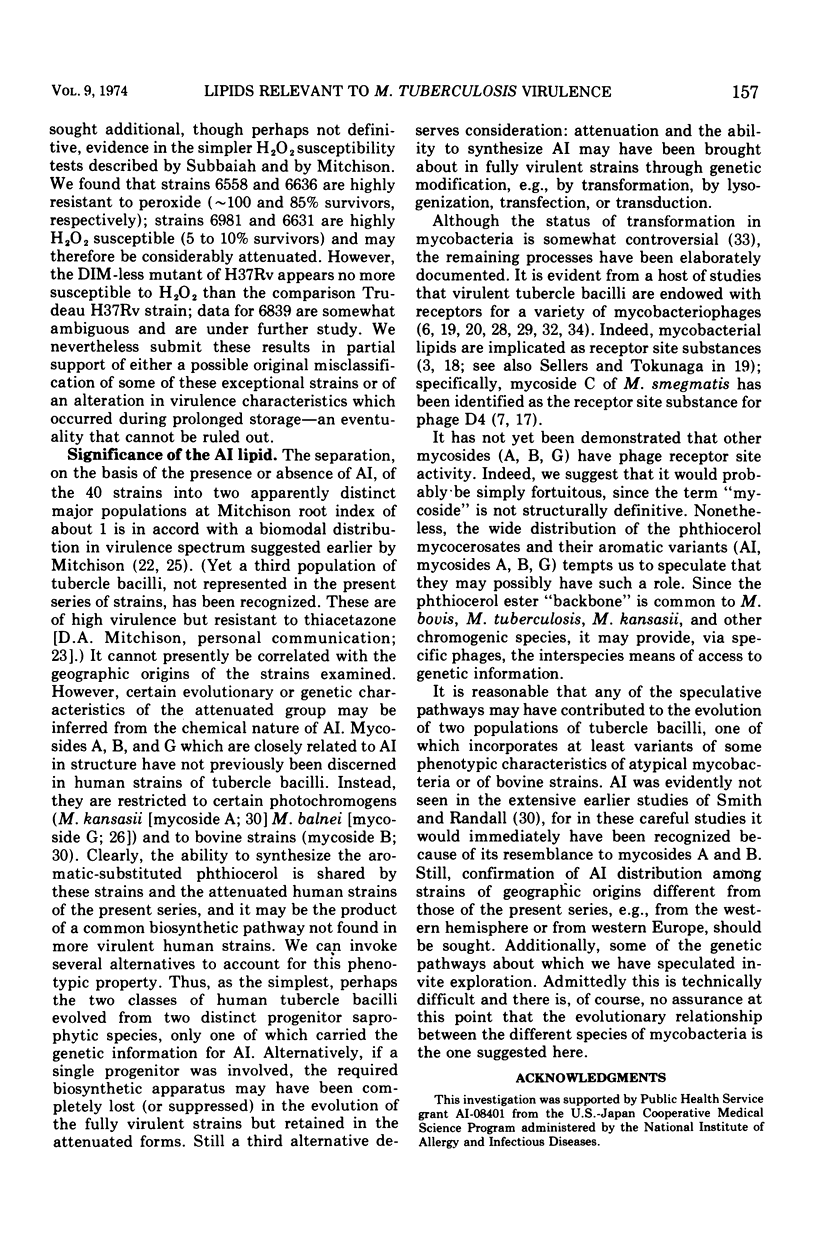
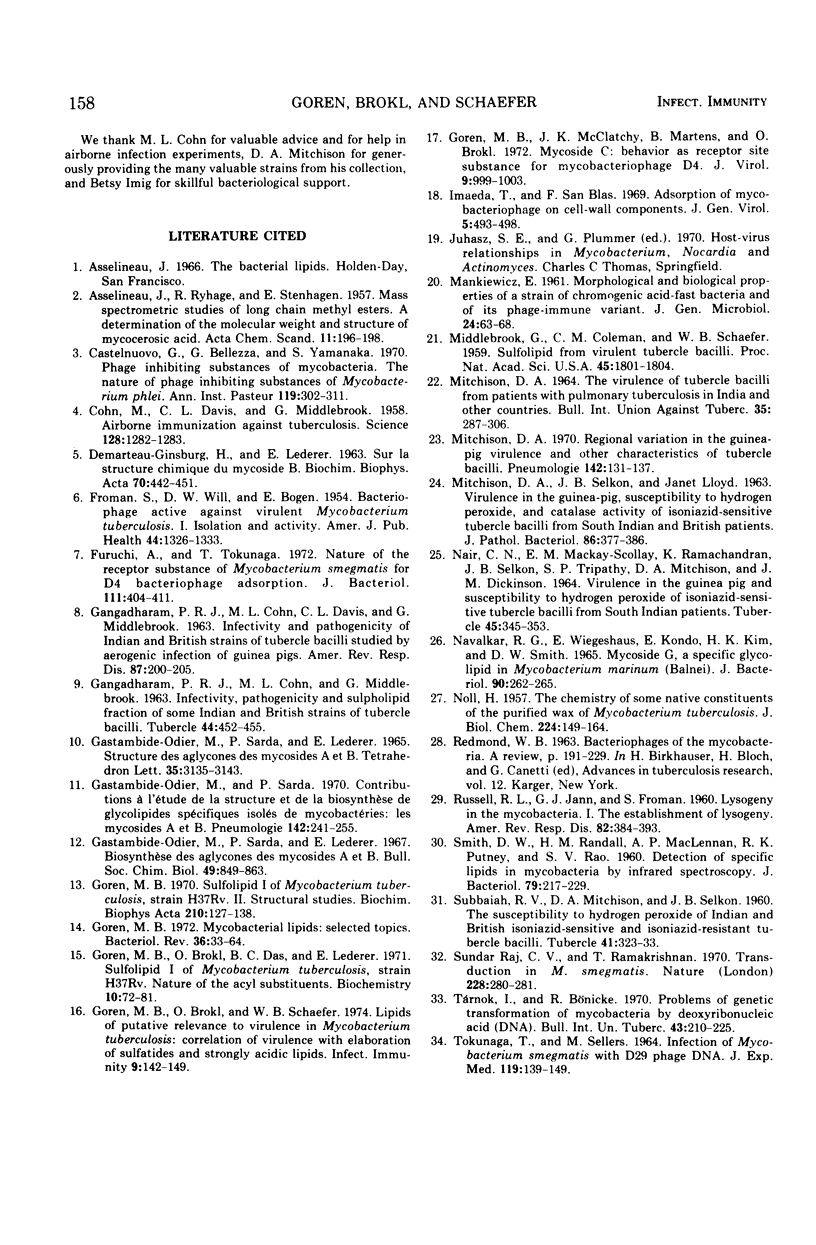
Images in this article
Selected References
These references are in PubMed. This may not be the complete list of references from this article.
- COHN M. L., DAVIS C. L., MIDDLEBROOK G. Airborne immunization against tuberculosis. Science. 1958 Nov 21;128(3334):1282–1283. doi: 10.1126/science.128.3334.1282. [DOI] [PubMed] [Google Scholar]
- Castelnuovo G., Bellezza G., Yamanaka S. Phage inhibiting substances of mycobacteria. I. The nature of phage inhibiting substances of Mycobacterium phlei. Ann Inst Pasteur (Paris) 1970 Sep;119(3):302–311. [PubMed] [Google Scholar]
- DEMARTEAU-GINSBURG H., LEDERER E. SUR LA STRUCTURE CHIMIQUE DU MYCOSIDE B. Biochim Biophys Acta. 1963 Aug 27;70:442–451. doi: 10.1016/0006-3002(63)90774-1. [DOI] [PubMed] [Google Scholar]
- FROMAN S., WILL D. W., BOGEN E. Bacteriophage active against virulent Mycobacterium tuberculosis. I. Isolation and activity. Am J Public Health Nations Health. 1954 Oct;44(10):1326–1333. doi: 10.2105/ajph.44.10.1326. [DOI] [PMC free article] [PubMed] [Google Scholar]
- Furuchi A., Tokunaga T. Nature of the receptor substance of Mycobacterium smegmatis for D4 bacteriophage adsorption. J Bacteriol. 1972 Aug;111(2):404–411. doi: 10.1128/jb.111.2.404-411.1972. [DOI] [PMC free article] [PubMed] [Google Scholar]
- GANGADHARAM P. R., COHN M. L., DAVIS C. L., MIDDLEBROOK G. Infectivity and pathogenicity of Indian and British strains of tubercle bacilli studied by aerogenic infection of guinea pigs. Am Rev Respir Dis. 1963 Feb;87:200–205. doi: 10.1164/arrd.1963.87.2.200. [DOI] [PubMed] [Google Scholar]
- GANGADHARAM P. R., COHN M. L., MIDDLEBROOK G. INFECTIVITY, PATHOGENICITY AND SULPHOLIPID FRACTION OF SOME INDIAN AND BRITISH STRAINS OF TUBERCLE BACILLI. Tubercle. 1963 Dec;44:452–455. doi: 10.1016/s0041-3879(63)80087-2. [DOI] [PubMed] [Google Scholar]
- Gastambide-Odier M., Lederer E., Sarda P. Structure des aglycones des mycosides A et B. Tetrahedron Lett. 1965 Sep;(35):3135–3143. doi: 10.1016/s0040-4039(01)89234-0. [DOI] [PubMed] [Google Scholar]
- Gastambide-Odier M., Sarda P. Contribution à l'étude de la structure et de la biosynthèse de glycolipides spécifiques isolés de mycobactéries: les mycosides a et b. Pneumonologie. 1970;142(2):241–255. doi: 10.1007/BF02095222. [DOI] [PubMed] [Google Scholar]
- Gastambide-Odier M., Sarda P., Lederer E. Biosynthèse des aglycones des mycosides A et B. Bull Soc Chim Biol (Paris) 1967 Jul 27;49(7):849–864. [PubMed] [Google Scholar]
- Goren M. B., Brokl O., Das B. C., Lederer E. Sulfolipid I of Mycobacterium tuberculosis, strain H37RV. Nature of the acyl substituents. Biochemistry. 1971 Jan 5;10(1):72–81. doi: 10.1021/bi00777a012. [DOI] [PubMed] [Google Scholar]
- Goren M. B., Brokl O., Schaefer W. B. Lipids of putative relevance to virulence in Mycobacterium tuberculosis: correlation of virulence with elaboration of sulfatides and strongly acidic lipids. Infect Immun. 1974 Jan;9(1):142–149. doi: 10.1128/iai.9.1.142-149.1974. [DOI] [PMC free article] [PubMed] [Google Scholar]
- Goren M. B., McClatchy J. K., Martens B., Brokl O. Mycosides C: behavior as receptor site substance for mycobacteriophage D4. J Virol. 1972 Jun;9(6):999–1003. doi: 10.1128/jvi.9.6.999-1003.1972. [DOI] [PMC free article] [PubMed] [Google Scholar]
- Goren M. B. Mycobacterial lipids: selected topics. Bacteriol Rev. 1972 Mar;36(1):33–64. doi: 10.1128/br.36.1.33-64.1972. [DOI] [PMC free article] [PubMed] [Google Scholar]
- Goren M. B. Sulfolipid I of Mycobacterium tuberculosis, strain H37Rv. II. Structural studies. Biochim Biophys Acta. 1970 Jun 9;210(1):127–138. doi: 10.1016/0005-2760(70)90068-8. [DOI] [PubMed] [Google Scholar]
- MANKIEWICZ E. Morphological and biological properties of a strain of chromogenic acid-fast bacteria and of its phage-immune variant. J Gen Microbiol. 1961 Jan;24:63–68. doi: 10.1099/00221287-24-1-63. [DOI] [PubMed] [Google Scholar]
- MITCHISON D. A., SELKON J. B., LLOYD J. VIRULENCE IN THE GUINEA-PIG, SUSCEPTIBILITY TO HYDROGEN PEROXIDE, AND CATALASE ACTIVITY OF ISONIAZID-SENSITIVE TUBERCLE BACILLI FROM SOUTH INDIAN AND BRITISH PATIENTS. J Pathol Bacteriol. 1963 Oct;86:377–386. doi: 10.1002/path.1700860213. [DOI] [PubMed] [Google Scholar]
- MITCHISON D. A. THE VIRULENCE OF TUBERCLE BACILLI FROM PATIENTS WITH PULMONARY TUBERCULOSIS IN INDIA AND OTHER COUNTRIES. Bull Int Union Tuberc. 1964 Sep;35:287–306. [PubMed] [Google Scholar]
- Middlebrook G., Coleman C. M., Schaefer W. B. SULFOLIPID FROM VIRULENT TUBERCLE BACILLI. Proc Natl Acad Sci U S A. 1959 Dec;45(12):1801–1804. doi: 10.1073/pnas.45.12.1801. [DOI] [PMC free article] [PubMed] [Google Scholar]
- Mitchison D. A. Regional variation in the guinea-pig virulence and other characteristics of tubercle bacilli. Pneumonologie. 1970;142(2):131–137. doi: 10.1007/BF02095209. [DOI] [PubMed] [Google Scholar]
- NAIR C. N., MACKAY-SCOLLAY E. M., RAMACHANDRAN K., SELKON J. B., TRIPATHY S. P., MITCHISON D. A., DICKINSON J. M. VIRULENCE IN THE GUINEA-PIG AND SUSCEPTIBLITY TO HYDROGEN PEROXIDE OF ISONIAZID-SENSITIVE TUBERCLE BACILLI FROM SOUTH INDIAN PATIENTS. Tubercle. 1964 Dec;45:345–353. doi: 10.1016/s0041-3879(64)80048-9. [DOI] [PubMed] [Google Scholar]
- NOLL H. The chemistry of some native constituents of the purified wax of Mycobacterium tuberculosis. J Biol Chem. 1957 Jan;224(1):149–164. [PubMed] [Google Scholar]
- Navalkar R. G., Wiegeshaus E., Kondo E., Kim H. K., Smith D. W. Mycoside G, a Specific Glycolipid in Mycobacterium marinum (Balnei). J Bacteriol. 1965 Jul;90(1):262–265. doi: 10.1128/jb.90.1.262-265.1965. [DOI] [PMC free article] [PubMed] [Google Scholar]
- RUSSELL R. L., JANN G. J., FROMAN S. Lysogeny in the mycobacteria. 1. The establishment of lysogeny. Am Rev Respir Dis. 1960 Sep;82:384–393. doi: 10.1164/arrd.1960.82.3.384. [DOI] [PubMed] [Google Scholar]
- Raj C. V., Ramakrishnan T. Transduction in Mycobacterium smegmatis. Nature. 1970 Oct 17;228(5268):280–281. doi: 10.1038/228280b0. [DOI] [PubMed] [Google Scholar]
- SMITH D. W., RANDALL H. M., MACLENNAN A. P., PUTNEY R. K., RAO S. V. Detection of specific lipids in mycobacteria by infrared spectroscopy. J Bacteriol. 1960 Feb;79:217–229. doi: 10.1128/jb.79.2.217-229.1960. [DOI] [PMC free article] [PubMed] [Google Scholar]
- TOKUNAGA T., SELLERS M. INFECTION OF MYCOBACTERIUM SMEGMATIS WITH D29 PHAGE DNA. J Exp Med. 1964 Jan 1;119:139–149. doi: 10.1084/jem.119.1.139. [DOI] [PMC free article] [PubMed] [Google Scholar]
- Tárnok I., Bönicke R. Problems of genetic transformation of mycobacteria by deoxyribonucleic acid (DNA). Bull Int Union Tuberc. 1970 Jun;43:210–213. [PubMed] [Google Scholar]



